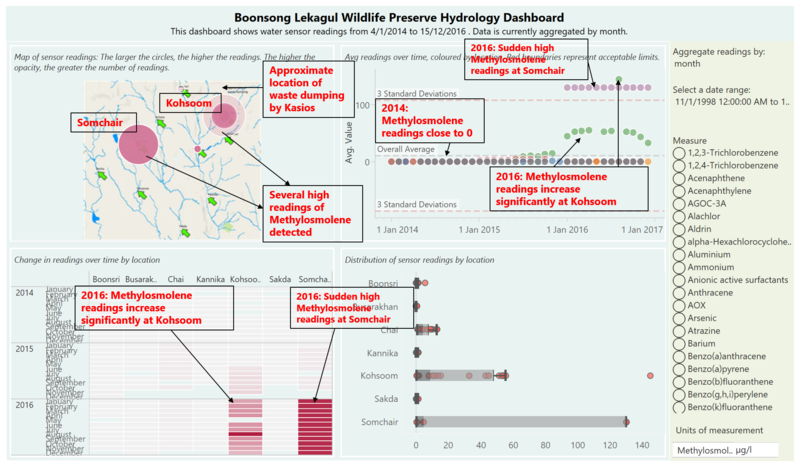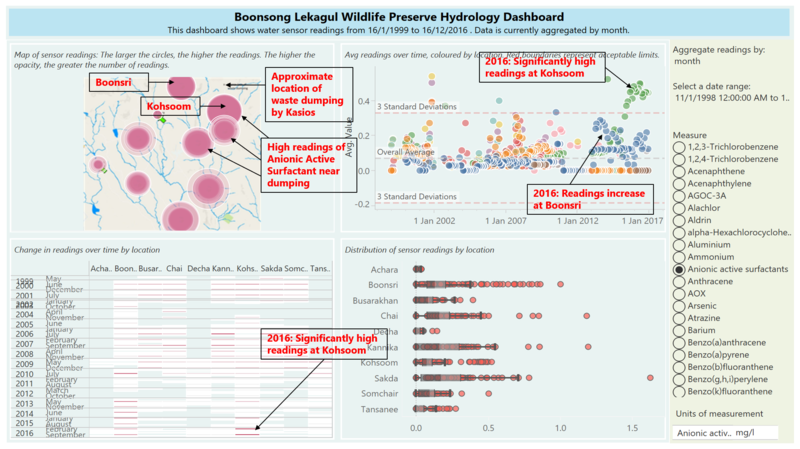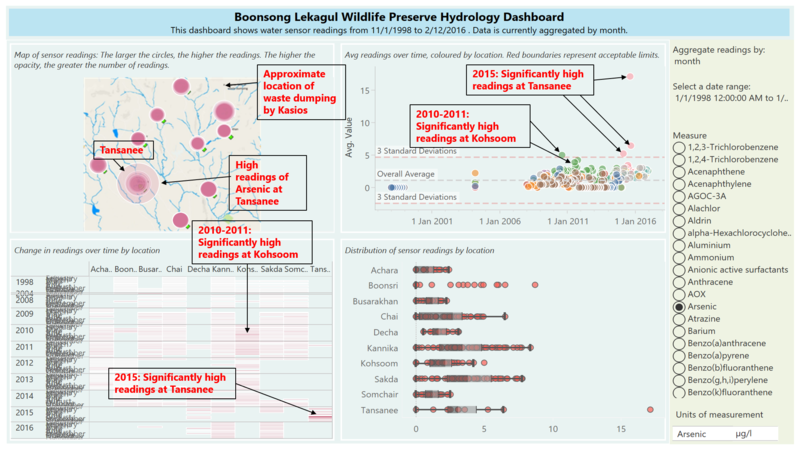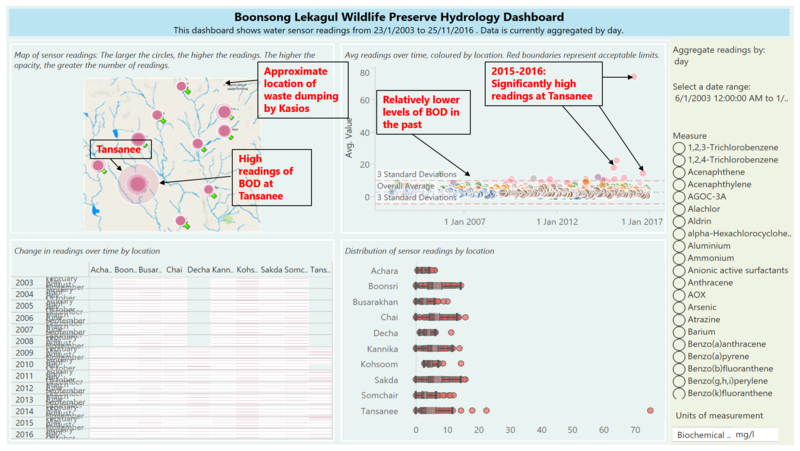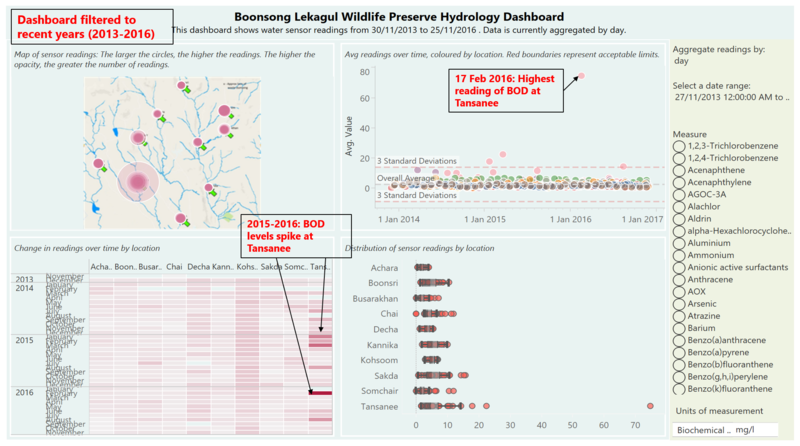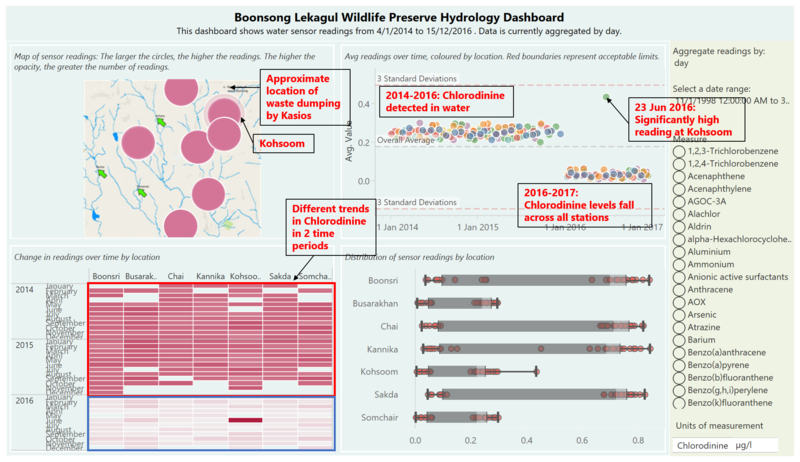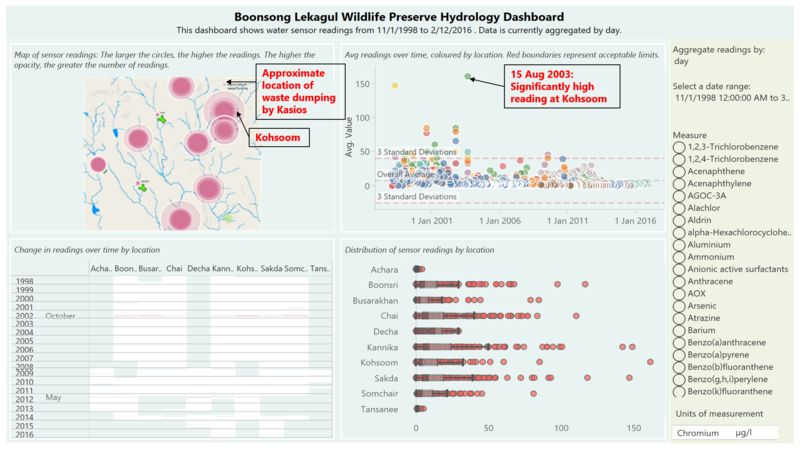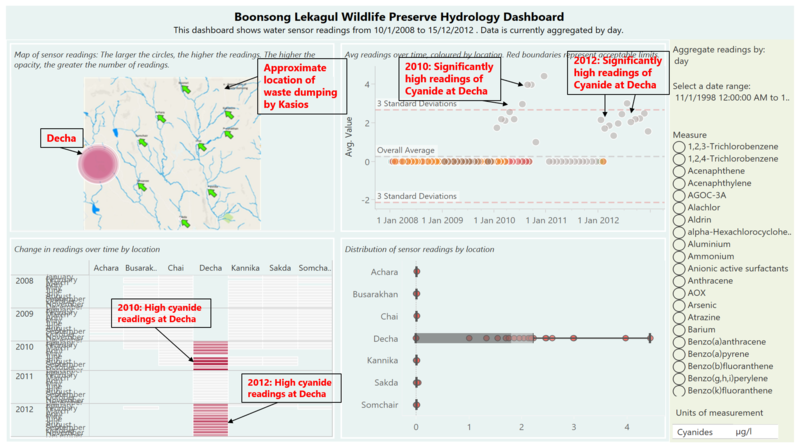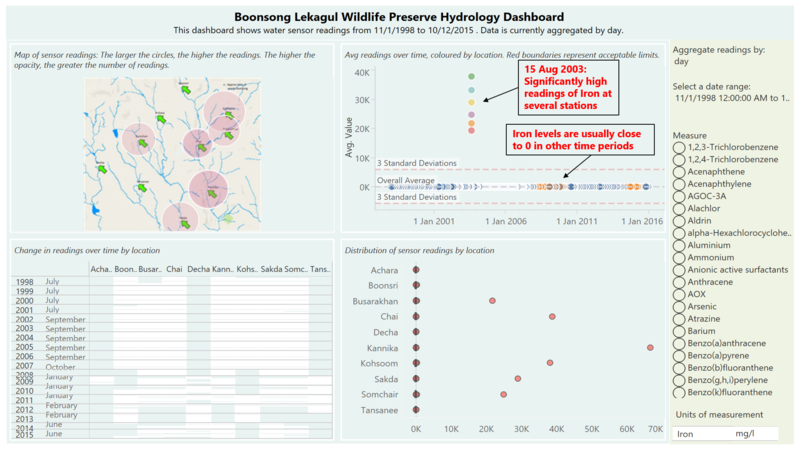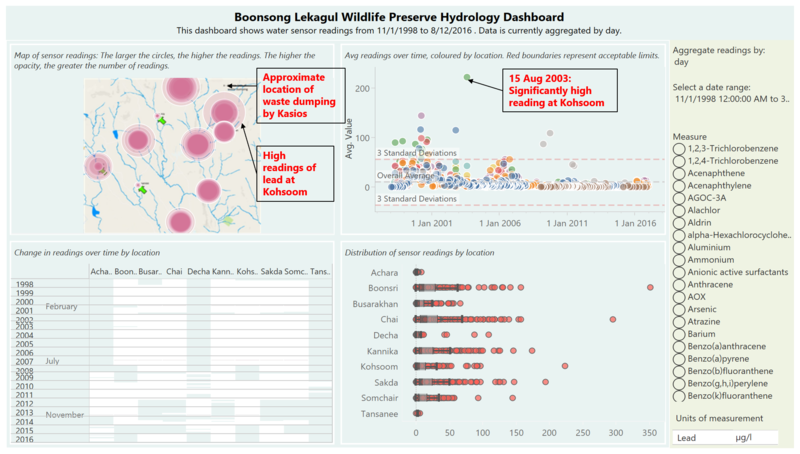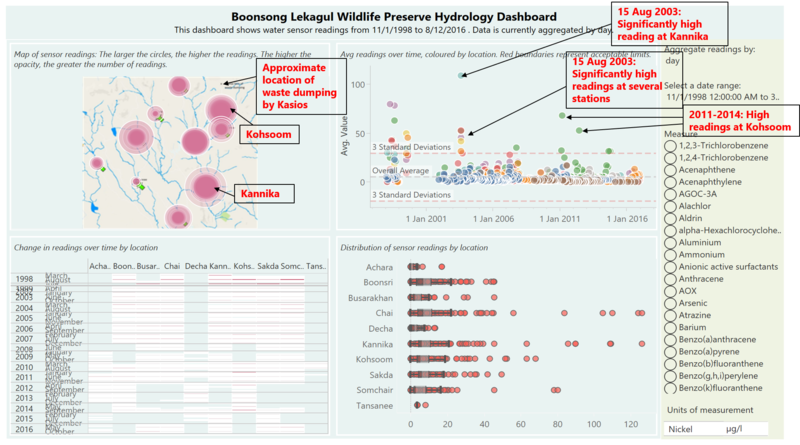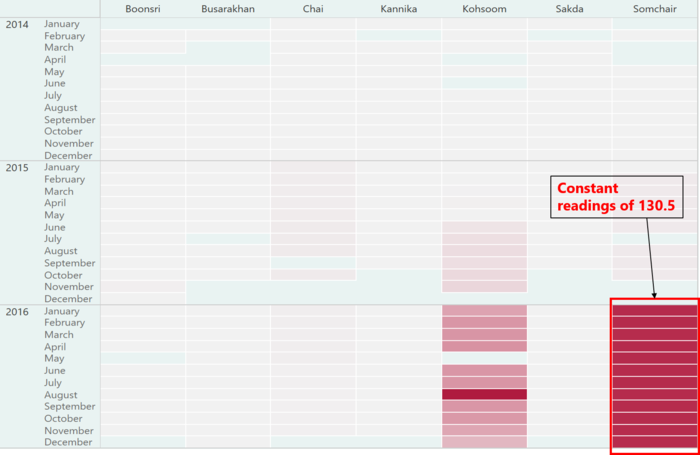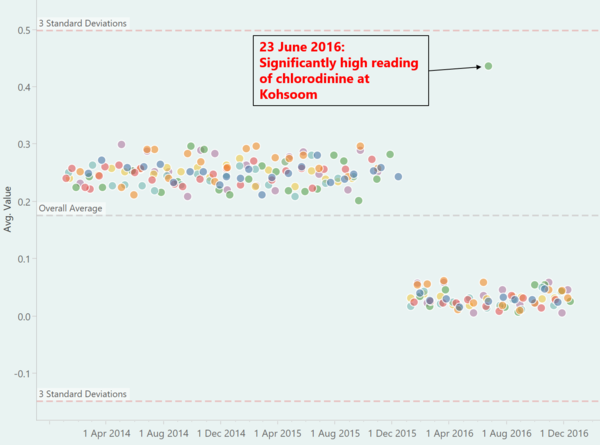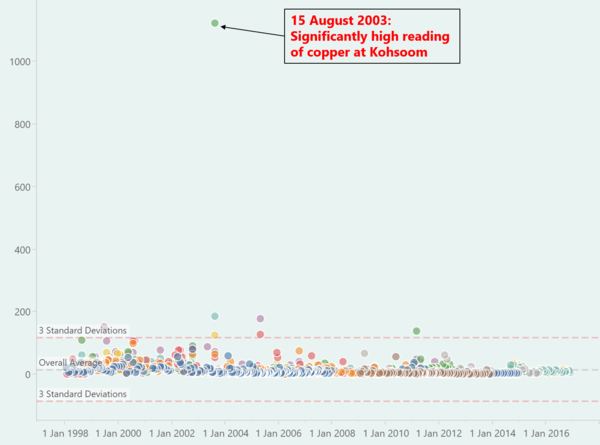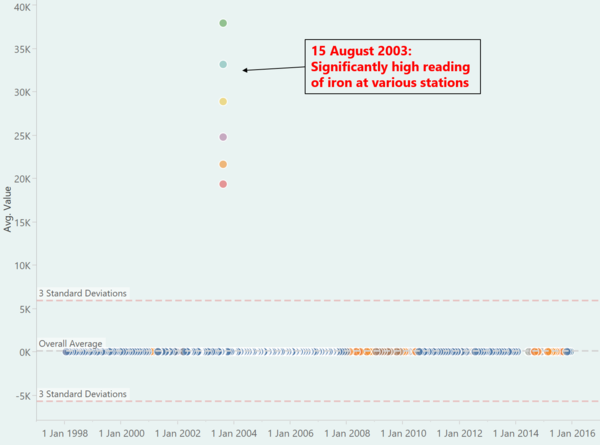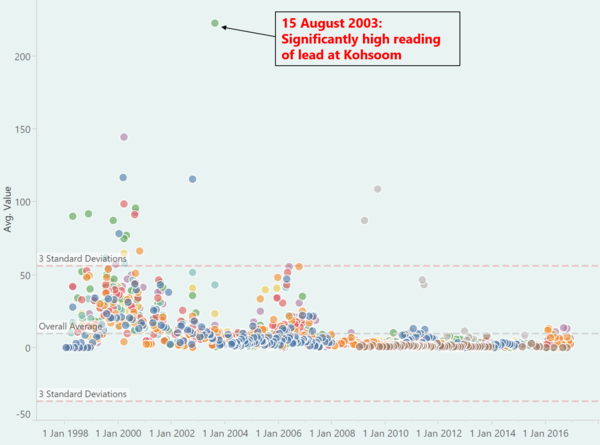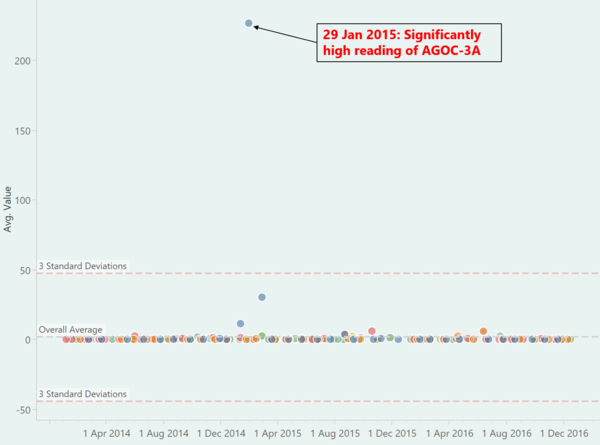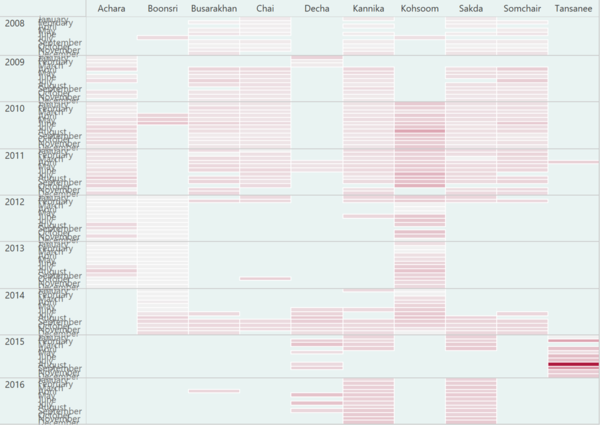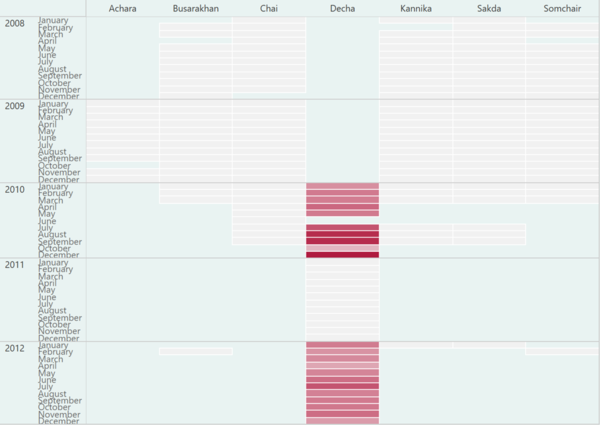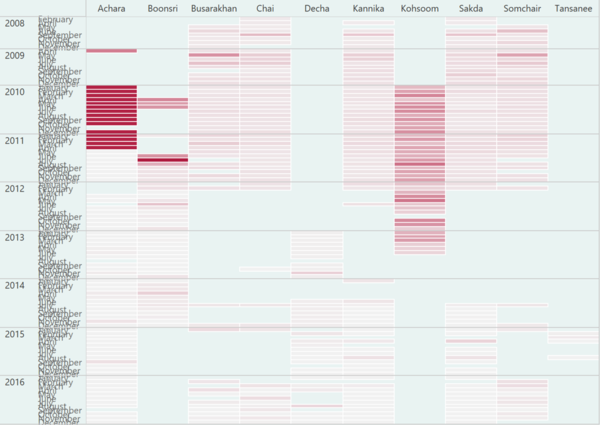 VAST Challenge 2018 MC2: Suspense at the Wildlife Preserve
VAST Challenge 2018 MC2: Suspense at the Wildlife Preserve
Insights from Viz
Chemical Contamination: Trends of possible interest
| Insights |
Visualization |
| 1. Toxic manufacturing chemical - Methylosmolene
Sensor readings of Methylosmolene started from 2014, and only at the stations of Boonsri, Busarakhan, Chai, Kannika, Kohsoom, Sakda and Somchair. From 2014 to 2015, sensor readings of this toxic chemical was close to zero. However, in 2016, Methylosmolene readings at Somchair suddenly spiked to a very high, constant value of statistical significance (greater than 3 standard deviations from the mean. Readings also increased sharply at Kohsoom, which is the closest station to the approximate location of alleged waste dumping by Kasios.
Further investigation of these high Methylosmolene readings reveals that at Somchair, the high readings were constant at 130.5 ug/l throughout the year of 2016 without any change. It is possible that there could have been a problem with the sensor.
At Kohsoom, readings started increasing since the mid of 2015. There is one particularly high reading of Methylosmolene on 26 August 2016, which surpasses even the readings detected at Somchair.
|
|
| 2. Anionic Active Surfactant
The station closest to the suspected waste dumping, Kohsoom, also detects significantly high readings of Anionic Active Surfactant in 2016. Readings also increased at Boonsri, which is relatively close to the dumping site as well.
|
|
| 3. Arsenic
Arsenic is known to be a very toxic contaminant in soil. Stations started picking up readings of Arsenic since 2008. Levels of Arsenic stayed close to zero until 2010, where readings at Kohsoom saw a significant increase. In fact, on 26 August 2010, there was a statistically significant increase in Arsenic levels at Kohsoom. Levels remained high in 2011.
In recent times, spikes of Arsenic sensor readings were detected in Tansanee, in 2015. There was an extraordinary high reading of Arsenic at Tansanee on 13 August 2015 (17.15 ug/l). This is the highest level of Arsenic recorded in the history of the data, which is a genuine cause of concern.
|
|
| 4. Biochemical Oxygen Demand
Another important indicator of water pollution is Biochemical Oxygen Demand (BOD). Rivers are considered severely polluted when levels of BOD exceed 8 mg/l. In 2015-2016, the Tansanee station has seen significant increase in BOD levels. There was an extraordinary high reading of BOD at Tansanee on 17 February 2016 (74.71 mg/l), which is of great concern as it almost 10 times above the limit mentioned earlier. The rivers at Tansanee in recent times is severely polluted.
The filtered dashboard show the spikes in BOD at Tansanee in recent times.
|
|
| 5. Chlorodinine
The previous VAST challenge identified chlorodinine as one of the toxic chemical contaminants produced by factories in the preserve. From 2014-2016, levels of chlorodinine were constant across all stations but then abruptly fell from 2016-2017. One possible reason for this sudden decline is the introduction of environmental regulations in the preserve. However, on 23 June 2016, there was a spike in chlorodinine readings at Kohsoom, the closest station to the location of waste dumping. It is possible that the waste dumping occurred that day and is worth an investigation.
|
|
| 6. Chromium
The manufacture of stainless steel and sewage sludge are sources of chromium contamination in soils. It is an environmental concern because excessive concentrations are toxic to living organisms. A significant reading of chromium was detected on 15 August 2003 at Kohsoom, the station closest to the site of waste dumping.
|
|
| 7. Cyanides
Cyanide is very toxic to living organisms and its removal from water is critical. While there has not been high levels of cyanide detected in areas close to the location of the waste dumping, significantly high readings of cyanide were detected in Decha, in 2010 and 2012. Investigations should be carried out in any industrial sites near the area as these sensor readings are a cause for concern.
|
|
| 8. Iron
While iron is not known to be a key contaminant in soil, it is worth noting that on 15 August 2003, significantly high readings of iron were captured at several stations similar to chromium above. These anomalies are interesting because iron levels are close to zero during other time periods.
|
|
| 9. Lead
Sewage sludge is a source of lead contamination in soils. While lead readings are generally close to zero in recent times, there was a significantly high reading detected at Kohsoom on 15 August 2003, the same day during which especially high levels of chromium and iron were detected at several locations.
|
|
| 10. Nickel
Nickel is also produced by industrial activities with sewage sludge a common source. At excessive concentrations, it is toxic to living organisms. On 15 August 2003, significantly high levels of nickel were detected across several stations: Kannika (the highest reading), Chai, Kohsoom, Somchair and Sakda. In 2011, 2012 and 2014, Kohsoom also saw high Nickel readings detected.
|
|
Anomalies in the dataset
| Anomalies |
Visualization |
|---|
1. Methylosmolene
There are anomalies found in the sensor readings for methylosmolene. In 2016, the Somchair station detects significantly high, constant readings of 130.5 ug/l. Since the values are the same throughout the year, these readings are most likely anomalies. The sensor could be having issues. |
|
| 2. Chlorodinine
On 23 June 2016, there is a abrupt spike in chlorodinine levels at Kohsoom even though chlorodinine levels are low across all other locations during that period. An industrial site near Kohsoom might have breached environmental regulations at the time, and could potentially be Kasios since Kohsoom is the closest station to the suspected waste dumping.
|
|
3. Copper
On 15 August 2003, a particular high level of copper was detected at Kohsoom. |
|
4. Iron
On 15 August 2003, high levels of iron were detected across various stations. |
|
5. Lead
On 15 August 2003, high levels of lead was detected at Kohsoom. |
|
6. AGOC-3A
On 29 January 2015, a high reading of AGOC-3A was detected at Boonsri. |
|
Wildlife Concern
To investigate the impact on the Pipit and wildlife, the data visualization will focus on chemicals that are toxic to living organisms.
| Concerns |
Visualization |
1. Arsenic
Arsenic is a heavy metal that is known to be extremely toxic to living organisms. It is therefore worrying that Arsenic readings are prevalent across the preserve since 2008, with particularly high readings in Tansanee in 2015. |
|
2. Cyanides
Cyanide is also known to be toxic to living organisms. However, sensor readings of cyanide are not comprehensive. Small levels of cyanide are detected from 2008 across several stations but the readings stop in 2010. From 2010 to 2012, cyanide readings are present in Decha with worryingly high levels in 2010 and 2012. |
|
3. Mercury
Mercury is toxic to living organisms. Since 2008 there have been detection of mercury across several stations in the preserve, with Achara having the highest levels in 2010 and 2011, and Kohsoom (the station nearest to the waste dumping site) also having high levels from 2010 to 2013. However, there are no longer any sensor readings at Kohsoom from the middle of 2013 so the status of mercury levels there in recent times is unclear. |
|
4. Cyanides
Cyanide is also known to be toxic to living organisms. However, sensor readings of cyanide are not comprehensive. Small levels of cyanide are detected from 2008 across several stations but the readings stop in 2010. From 2010 to 2012, cyanide readings are present in Decha with worryingly high levels in 2010 and 2012. |
|
2. Cyanides
Cyanide is also known to be toxic to living organisms. However, sensor readings of cyanide are not comprehensive. Small levels of cyanide are detected from 2008 across several stations but the readings stop in 2010. From 2010 to 2012, cyanide readings are present in Decha with worryingly high levels in 2010 and 2012. |
|
2. Cyanides
Cyanide is also known to be toxic to living organisms. However, sensor readings of cyanide are not comprehensive. Small levels of cyanide are detected from 2008 across several stations but the readings stop in 2010. From 2010 to 2012, cyanide readings are present in Decha with worryingly high levels in 2010 and 2012. |
|

